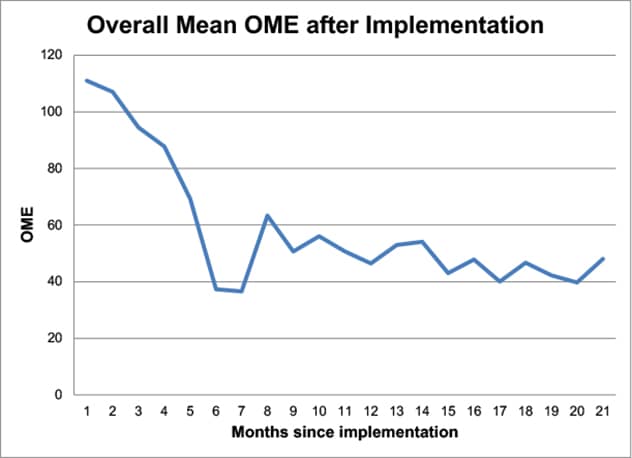Sept. 15, 2020
实施处方指南后口服吗啡等效药物的总平均数

实施处方指南后口服吗啡等效药物的总平均数
在妙佑医疗国际实施阿片类药物处方指南后,开具口服吗啡等效药物的处方显著减少。
Over the past two decades, physicians have relied on opioid medications to manage acute and chronic pain, especially in the postoperative setting. Despite efforts to combat the opioid epidemic, standardized guidelines for opioid prescribing are lacking for most surgical subspecialties.
Mayo Clinic aims to be at the forefront in identifying solutions for this complex issue. In 2017, a multidisciplinary task force consisting of Mayo Clinic urologists, anesthesiologists, pharmacists, nurses and health services research experts came together to establish evidence-based guidelines for postoperative prescribing within Mayo Clinic Urology. These guidelines were based on historical prescribing data for nearly 12,000 patients across Mayo Clinic's Minnesota, Arizona and Florida sites, and the results were ultimately published in Mayo Clinic Proceedings in 2019.
Matthew (Matt) J. Ziegelmann, M.D., a urologist at Mayo Clinic in Rochester, Minnesota, has played an important role in implementing these guidelines within Urology across all three Mayo Clinic sites. Instead of proposing procedure-specific guidelines, 21 urologic procedures were grouped into four tiers based on both historical data and task force assessment of perceived pain based on varying levels of invasiveness. A maximum oral morphine equivalent (OME) was agreed upon for each tier, and these evidence-based guidelines were distributed to prescribers at each site to implement starting Jan. 1, 2018.
Initial data on prescribing patterns four months after guideline implementation were published in the American Journal of Surgery earlier this year. In this short time, a median quantity of 100 OME (roughly 13 5 mg oxycodone tablets) was prescribed compared with 150 OME before guideline implementation. There was no significant change in refill requests despite this significant decrease in prescribing.
In an early analysis of two-year post-guideline data, even more promising results were found. The overall median quantity prescribed has decreased to 0 OME, and there was a significant decrease in prescribing within each tier in addition to each of the 21 individual procedures included. Overall guideline adherence was an impressive 90%.
Future studies will be directed at examining patient use in order to enhance subsequent iterations of the guidelines.
For more information
Ziegelmann M, et al. Wide variation in opioid prescribing after urological surgery in tertiary care centers. Mayo Clinic Proceedings. 2019;94:262.
Ziegelmann M, et al. Comparison of prescribing patterns before and after implementation of evidence-based opioid prescribing guidelines for the postoperative urologic surgery patient. American Journal of Surgery. 2020;220:499.